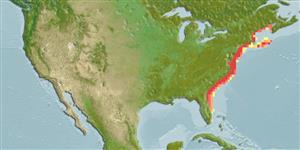>
Clupeiformes (Herrings) >
Alosidae (Shads and Sardines)
Etymology: Alosa: Latin, alausa = a fish cited by Ausonius and Latin, halec = pickle, dealing with the Greek word hals = salt; it is also the old Saxon name for shad = "alli" ; 1591 (Ref. 45335).
More on author: Mitchill.
Environment: milieu / climate zone / depth range / distribution range
Ökologie
seewasser; süßwasser; brackwasser; anadrom (Ref. 51243). Temperate; 46°N - 25°N, 82°W - 66°W (Ref. 117467)
Western Atlantic: along the coast from Maine to the St. John's River, Florida, USA (Ref. 188). Possibly in Campobello Island, New New Brunswick, Canada (Ref. 86798).
Length at first maturity / Size / Gewicht / Alter
Maturity: Lm 32.0 range ? - ? cm
Max length : 60.0 cm SL Männchen/unbestimmt; (Ref. 188); common length : 34.0 cm SL Männchen/unbestimmt; (Ref. 188)
Rückenflossenstacheln (insgesamt): 0; Rückenflossenweichstrahlen (insgesamt): 15-20; Afterflossenstacheln 0; Afterflossenweichstrahlen: 19 - 23; Wirbelzahl: 53 - 55. Belly with distinct keel of scutes. Lower jaw very prominent, but not rising steeply within mouth; teeth reduced or in upper jaw absent in fishes over 23 cm standard length. A dark spot on shoulder, several obscure dark spots along flank (sometimes missing). Closely resembles A. chrysochloris which has stronger jaw teeth, no shoulder spot and the body depth less than head length (Ref. 188). Silvery, with a dark grayish green back (Ref. 7251).
In freshwater habitat, this species occurs in open water of large rivers (Ref. 86798). Schools of adults are found in marine waters, along the coast; also estuaries, tidal rivers and tributaries during late spring and early summer (Ref. 4639). Juveniles tend to leave nursery areas during summer (Ref. 4639). Feeds on small fishes, also squid, small crabs and other crustaceans, as well as fish eggs. Spawn in tidal freshwater (Patuxent River, Chesapeake Bay in May) (Ref. 188), and return to the sea shortly after (Ref. 4639). Parasites found are nematodes, cestodes and trematodes (Ref. 37032).
Whitehead, P.J.P., 1985. FAO Species Catalogue. Vol. 7. Clupeoid fishes of the world (suborder Clupeoidei). An annotated and illustrated catalogue of the herrings, sardines, pilchards, sprats, shads, anchovies and wolf-herrings. FAO Fish. Synop. 125(7/1):1-303. Rome: FAO. (Ref. 188)
IUCN Rote Liste Status (Ref. 130435)
Bedrohung für Menschen
Harmless
Nutzung durch Menschen
Fischereien: weniger kommerziell
Mehr Information
PartnerBilderStamps, Coins Misc.LauteCiguateraGeschwindigkeitSchwimmstilKiemenoberflächeOtolithsGehirngrößeSehfähigkeit
Tools
Zusatzinformationen
Download XML
Internet Quellen
Estimates based on models
Preferred temperature (Ref.
123201): 8.4 - 25.5, mean 14 °C (based on 238 cells).
Phylogenetic diversity index (Ref.
82804): PD
50 = 0.5000 [Uniqueness, from 0.5 = low to 2.0 = high].
Bayesian length-weight: a=0.00794 (0.00370 - 0.01703), b=3.04 (2.87 - 3.21), in cm total length, based on LWR estimates for this Genus-body shape (Ref.
93245).
Trophic level (Ref.
69278): 4.1 ±0.58 se; based on food items.
Generation time: 3.7 ( na - na) years. Estimated as median ln(3)/K based on 1
growth studies.
Widerstandsfähigkeit (Ref.
120179): mittel, Verdopplung der Population dauert 1,4 - 4,4 Jahre. (K=0.3).
Fishing Vulnerability (Ref.
59153): Moderate vulnerability (41 of 100).
Climate Vulnerability (Ref.
125649): Moderate to high vulnerability (55 of 100).
Nutrients (Ref.
124155): Calcium = 11.5 [5.3, 62.2] mg/100g; Iron = 0.599 [0.251, 1.331] mg/100g; Protein = 19.5 [17.0, 22.3] %; Omega3 = 1.42 [0.75, 2.70] g/100g; Selenium = 12.1 [5.9, 24.0] μg/100g; VitaminA = 20.4 [5.1, 78.2] μg/100g; Zinc = 0.266 [0.167, 0.456] mg/100g (wet weight);
